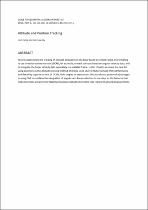JavaScript is disabled for your browser. Some features of this site may not work without it.
- ResearchSpace
- →
- Research Publications/Outputs
- →
- Book Chapters
- →
- View Item
| dc.contributor.author |
Candy, LP

|
|
| dc.contributor.author |
Lasenby, J

|
|
| dc.date.accessioned | 2012-07-27T11:25:07Z | |
| dc.date.available | 2012-07-27T11:25:07Z | |
| dc.date.issued | 2011 | |
| dc.identifier.citation | Candy, LP and Lasenby, J. 2011. Attitude and position tracking. Guide to Geometric Algebra in Practice. Springer-Verlag, London, UK. | en_US |
| dc.identifier.isbn | 978-0-85729-810-2 | |
| dc.identifier.isbn | 978-0-85729-811-9 | |
| dc.identifier.uri | http://www.springerlink.com/content/r4451277177n9q72/ | |
| dc.identifier.uri | http://hdl.handle.net/10204/6016 | |
| dc.description | Copyright: 2011 Springer-Verlag. This is an ABSTRACT ONLY. | en_US |
| dc.description.abstract | Several applications require the tracking of attitude and position of a body based on velocity data. It is tempting to use direction cosine matrices (DCM), for example, to track attitude based on angular velocity data, and to integrate the linear velocity data separately in a suitable frame. In this chapter we make the case for using bivectors as the attitude tracking method of choice since several features make their performance and flexibility superior to that of DCMs, Euler angles or even rotors. We also discuss potential advantages in using CGA to combine the integration of angular and linear velocities in one step, as the features that make bivectors attractive for tracking rotations extend to bivectors that represent general displacements. | en_US |
| dc.language.iso | en | en_US |
| dc.publisher | Springer-Verlag | en_US |
| dc.relation.ispartofseries | Workflow;8605 | |
| dc.subject | Velocity data | en_US |
| dc.subject | Direction cosine matrices | en_US |
| dc.subject | DCM | en_US |
| dc.subject | Kinematics | en_US |
| dc.subject | Algebra | en_US |
| dc.subject | Geometric algebra | en_US |
| dc.subject | Bivectors | en_US |
| dc.subject | Conformal mapping | en_US |
| dc.title | Attitude and position tracking | en_US |
| dc.type | Book Chapter | en_US |
| dc.identifier.apacitation | Candy, L., & Lasenby, J. (2011). Attitude and position tracking., <i>Workflow;8605</i> Springer-Verlag. http://hdl.handle.net/10204/6016 | en_ZA |
| dc.identifier.chicagocitation | Candy, LP, and J Lasenby. "Attitude and position tracking" In <i>WORKFLOW;8605</i>, n.p.: Springer-Verlag. 2011. http://hdl.handle.net/10204/6016. | en_ZA |
| dc.identifier.vancouvercitation | Candy L, Lasenby J. Attitude and position tracking.. Workflow;8605. [place unknown]: Springer-Verlag; 2011. [cited yyyy month dd]. http://hdl.handle.net/10204/6016. | en_ZA |
| dc.identifier.ris | TY - Book Chapter AU - Candy, LP AU - Lasenby, J AB - Several applications require the tracking of attitude and position of a body based on velocity data. It is tempting to use direction cosine matrices (DCM), for example, to track attitude based on angular velocity data, and to integrate the linear velocity data separately in a suitable frame. In this chapter we make the case for using bivectors as the attitude tracking method of choice since several features make their performance and flexibility superior to that of DCMs, Euler angles or even rotors. We also discuss potential advantages in using CGA to combine the integration of angular and linear velocities in one step, as the features that make bivectors attractive for tracking rotations extend to bivectors that represent general displacements. DA - 2011 DB - ResearchSpace DP - CSIR KW - Velocity data KW - Direction cosine matrices KW - DCM KW - Kinematics KW - Algebra KW - Geometric algebra KW - Bivectors KW - Conformal mapping LK - https://researchspace.csir.co.za PY - 2011 SM - 978-0-85729-810-2 SM - 978-0-85729-811-9 T1 - Attitude and position tracking TI - Attitude and position tracking UR - http://hdl.handle.net/10204/6016 ER - | en_ZA |






